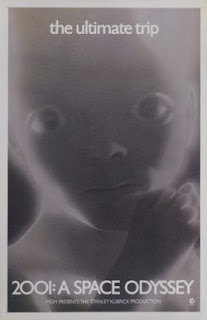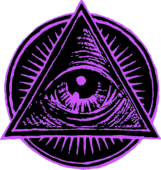This is the fifth installment in an ongoing series devoted to movies with psychedelic themes. The subject of this post is the 1968 film 2001: A Space Odyssey directed by Stanley Kubrick. Kubrick wrote the screenplay in association with Arthur C. Clarke, and Clarke wrote his own version of the 2001: A Space Odyssey as a novel. Spoiler alert: as always, the following discussion contains spoilers.
When 2001: A Space Odyssey was initially released it received some negative reviews, most notably from Pauline Kael, film critic for the New Yorker, who called it “a monumentally unimaginative movie.” MGM had spent $12 million on the film, the most they had spent on any film to that time, and they were worried about the effect this would have on the film’s box office. Initially billed as “An epic drama of adventure and exploration”, audiences were not prepared for the film’s slow pacing or its philosophical ambiguities. MGM brought in Mike Kaplan, who referred to himself as “the resident longhair in the publicity department of MGM”, to rethink the film’s marketing. Kaplan was aware that that the underground press had embraced the film and he decided to tap into the 1960s “youth revolution”. He noted that younger members of the audience and liked to get high during the concluding section of the film, “Jupiter and Beyond the Infinite”, and he designed a poster for the film to highlight its appeal to the counterculture. The poster read “The Ultimate Trip” and featured the image of the “star child” from the film’s final frames. Ultimately 2001: A Space Odyssey has come to be regarded as a classic with a reputation as psychedelic film.
 |
 |
The first two hours of 2001: A Space Odyssey offer little in the way of psychedelic imagery or influence. The concluding sequence, however, is extremely trippy. After disconnecting the malfunctioning HAL 9000 supercomputer, astronaut Dave Bowman pilots the pod toward the monolith, which is floating in space. Everything comes into alignment and Dave enters a color field. The dazzling show of visual effects goes on for over nine minutes. Initially Dave’s expression is one of wonder but it doesn’t take too long before he’s overwhelmed by the experience. As the scenes start to take on recognizable shapes once again we see Dave’s eye in extreme closeup through a variety of color filters. Finally when the ship comes to rest in a strange, elegant yet antiseptic room, Dave goes from having convulsions to seeing his life pass by a rapid succession, and then is reborn as a star child–the next level of human development–when the monolith reappears.
In a Rolling Stone interview Kubrick was asked about the influence of LSD on 2001: A Space Odyssey.
I have to say that it was never meant to represent an acid trip. On the other hand a connection does exist. An acid trip is probably similar to the kind of mind-boggling experience that might occur at the moment of encountering extraterrestrial intelligence. I’ve been put off experimenting with LSD because I don’t like what seems to happen to people who try it.
The mind altering that takes place in 2001: A Space Odyssey comes as a result of contact with the monolith that appears at various points through the film, and the monolith is presented as an alien entity completely outside of human experience. In the opening sequence, “The Dawn of Man”, based on Arthur C. Clarke’s short story “Encounter in the Dawn“, the monolith leads Moon-Watcher (as the main ape-man character is called in Clarke’s novel version of 2001: A Space Odyssey) to use tools and weapons. The monolith is next seen centuries later in an excavation site on the surface of the moon. This part of the story was initially based on another Clarke short story, “The Sentinel“, where the monolith sends some sort of signal upon its discovery by humans. In the movie, the signal brings about a mission to Jupiter aboard the spaceship Discovery to find the receiver. Dave Bowman is the only astronaut to survive the trip, however, as the on-board computer, the HAL 9000, tries to kill the crew before they reach their destination. Dave outsmarts the computer, however, and disconnects it so that he can carry out the mission. He finds a companion monolith, which leads him into the psychedelic color field and on his journey toward the next stage in human development. The monolith makes one more appearance at the end of Dave’s life, bringing on his rebirth as a star child.
Clarke’s novel version of 2001: A Space Odysseyoffers some clues as to the purpose of the monolith and its effect on those it contacts. The monolith is presented as advanced being that inspires creative thought through patient, repeated engagement. Kubrick’s monolith is more enigmatic and viewers are left wondering what it all means. I don’t claim to have the final word on that subject but I do have my own interpretation. Rob Ager‘s observation that the monolith represents a movie screen turned on end is persuasive. We never see the monolith oriented horizontally like a movie screen in the film, but about 1:40 after Dave enters the color field, the orientation of the light show shifts from vertical to horizontal, suggesting that viewers should alter our perspective in the same manner. Once that shift occurs, the color field changes to images suggesting the birth (or rebirth) of the heavens, followed by a descent to more familiar landscapes, though still rendered with psychedelic colors. I would argue that the monolith-as-movie-screen is not meant to be taken literally, but rather as an image of our dreams projected, limited only by the scope of our own imaginations.
2001: A Space Odyssey has a point to make about our relationship with technology. The faith in HAL as an infallible computer leads to disaster, and only when Dave is able to overcome HAL is he able to continue on the journey and be aided by the monolith. At one point Frank Poole (the other astronaut aboard the Discovery) responds to a question about what it’s like to be in “hibernation,” that is, held in suspended animation in a technological capsule. “Well it’s exactly like being asleep. You have absolutely no sense of time. The only difference is that you don’t dream.” Our reliance on technology has taken away our ability to dream. Only after Dave frees himself from HAL is he free to dream again. And while it is overwhelming at first, ultimately it allows him to progress to the next level of human development.

That was a realy nice and well writen review for the fellow psychonauts
In 2018, over a third of the public is reported to be awake to the FACT
that ‘space’, space travel and ‘evolution’ have been nothing more than
–massively– funded HOAXES and psy ops against MAN–kind.
That’s right kiddies !
We are –in fact– set on a great deep, and under a great deep.
What’s truly astonishing is to find ‘2001’ functioning even better as an
inside joke and send up by the INTEL deep innie – — Stanley CUBE–brick.
You know, the romance of a treadmill – – the allure of going absolutely NOWHERE
— – — but RUN thru the EYE.
The EYE of Hollywood idolatry.
And thru it all – -NOT a single good meal until the dead end.
And catch the toilet joke inserted right before the descent to the lunar surface.
LOL – –and UNDENIABLE !